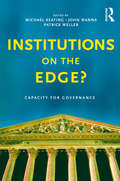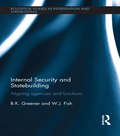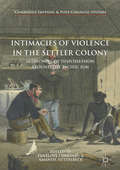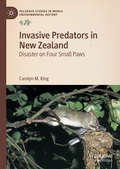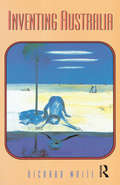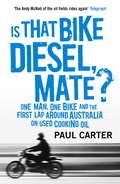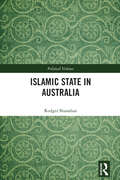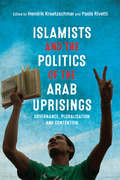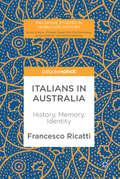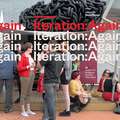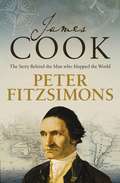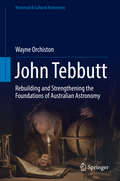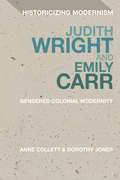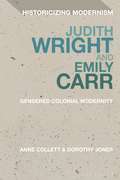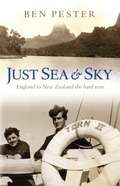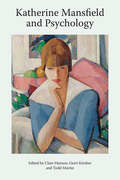- Table View
- List View
Institutions on the edge?: Capacity for governance
by Michael Keating John Wanna Patrick WellerAustralia faces major challenges to its forms of governance. Changing expectations from its citizens, global pressures on the economy and technological innovation are impacting on government operations. Yet most of its institutions were designed a hundred years ago. Cabinet government was inherited. Parliament was already established in its forms and procedures. The federal structure, the High Court and the federal public service were created as a consequence. The party structure has been effectively frozen since the 1920s and a tradition of handing some responsibilities to arms-length organisations was well established.So how have these institutions changed over the last hundred years and how well will they adapt to the demands of the modern world? Do they have the capacity to adapt appropriately and enable governments to achieve their preferred outcomes? In this book experienced academics and practitioners explore these questions. They examine each of the institutions in terms of their ability to meet new challenges and provide some hope that Australia's institutions, even if at times slow to move and dominated by internal interests, have a capacity to adapt and govern effectively. The book shows our political institutions in a new light, as dynamic, often flexible organisms; it provides important new insights into the way we are governed and how our system of governance might develop in the future.
Institutions on the edge?: Capacity for governance
by Michael Keating John Wanna Patrick WellerAustralia faces major challenges to its forms of governance. Changing expectations from its citizens, global pressures on the economy and technological innovation are impacting on government operations. Yet most of its institutions were designed a hundred years ago. Cabinet government was inherited. Parliament was already established in its forms and procedures. The federal structure, the High Court and the federal public service were created as a consequence. The party structure has been effectively frozen since the 1920s and a tradition of handing some responsibilities to arms-length organisations was well established.So how have these institutions changed over the last hundred years and how well will they adapt to the demands of the modern world? Do they have the capacity to adapt appropriately and enable governments to achieve their preferred outcomes? In this book experienced academics and practitioners explore these questions. They examine each of the institutions in terms of their ability to meet new challenges and provide some hope that Australia's institutions, even if at times slow to move and dominated by internal interests, have a capacity to adapt and govern effectively. The book shows our political institutions in a new light, as dynamic, often flexible organisms; it provides important new insights into the way we are governed and how our system of governance might develop in the future.
Internal Security and Statebuilding: Aligning Agencies and Functions (Routledge Studies in Intervention and Statebuilding)
by B. K. Greener W. J. FishThis book examines international efforts to provide security in post-conflict sites and explains why internal security should be given precedence in statebuilding endeavours. The work begins by exploring the evolution of security sectors in mature liberal democratic states, before examining the attempts of such states to accelerate that evolutionary process in post-conflict sites through statebuilding and security sector reform. These discussions suggest interestingly different answers to the question of who should provide for internal security in international operations. When considering mature states, there are both practical and normative reasons as to why internal security has become the sole domain of police, with military forces being excluded from internal affairs. In peace and stability operations, on the other hand, difficulties with utilising police personnel have led to military forces being required to play internal security roles. This tension is investigated further through detailed case studies of three recent missions: Afghanistan, Timor-Leste and Solomon Islands. These case studies both reinforce and augment the practical and normative reasons for ensuring that internal security remains the domain of police. This then impacts upon peace and stability operations in two important ways. If we are to provide enduring security in post-conflict sites, we should both (i) prioritise internal security agencies in security sector reform efforts, and (ii) prioritise ways of enabling police to play internal security roles in the contributing mission. This book will be of much interest to students of statebuilding, peace and conflict studies, military studies, police studies, historical sociology, security studies and IR in general.
Internal Security and Statebuilding: Aligning Agencies and Functions (Routledge Studies in Intervention and Statebuilding)
by B. K. Greener W. J. FishThis book examines international efforts to provide security in post-conflict sites and explains why internal security should be given precedence in statebuilding endeavours. The work begins by exploring the evolution of security sectors in mature liberal democratic states, before examining the attempts of such states to accelerate that evolutionary process in post-conflict sites through statebuilding and security sector reform. These discussions suggest interestingly different answers to the question of who should provide for internal security in international operations. When considering mature states, there are both practical and normative reasons as to why internal security has become the sole domain of police, with military forces being excluded from internal affairs. In peace and stability operations, on the other hand, difficulties with utilising police personnel have led to military forces being required to play internal security roles. This tension is investigated further through detailed case studies of three recent missions: Afghanistan, Timor-Leste and Solomon Islands. These case studies both reinforce and augment the practical and normative reasons for ensuring that internal security remains the domain of police. This then impacts upon peace and stability operations in two important ways. If we are to provide enduring security in post-conflict sites, we should both (i) prioritise internal security agencies in security sector reform efforts, and (ii) prioritise ways of enabling police to play internal security roles in the contributing mission. This book will be of much interest to students of statebuilding, peace and conflict studies, military studies, police studies, historical sociology, security studies and IR in general.
Intimacies of Violence in the Settler Colony: Economies of Dispossession around the Pacific Rim (Cambridge Imperial and Post-Colonial Studies Series)
by Penelope Edmonds Amanda NettelbeckViolence and intimacy were critically intertwined at all stages of the settler colonial encounter, and yet we know surprisingly little of how they were connected in the shaping of colonial economies. Extending a reading of ‘economies’ as labour relations into new arenas, this innovative collection of essays examines new understandings of the nexus between violence and intimacy in settler colonial economies of the British Pacific Rim. The sites it explores include cross-cultural exchange in sealing and maritime communities, labour relations on the frontier, inside the pastoral station and in the colonial home, and the material and emotional economies of exploration. Following the curious mobility of texts, objects, and frameworks of knowledge, this volume teases out the diversity of ways in which violence and intimacy were expressed in the economies of everyday encounters on the ground. In doing so, it broadens the horizon of debate about the nature of colonial economies and the intercultural encounters that were enmeshed within them.
Intimacies of Violence in the Settler Colony: Economies of Dispossession around the Pacific Rim (Cambridge Imperial and Post-Colonial Studies Series)
by Penelope Edmonds Amanda NettelbeckViolence and intimacy were critically intertwined at all stages of the settler colonial encounter, and yet we know surprisingly little of how they were connected in the shaping of colonial economies. Extending a reading of ‘economies’ as labour relations into new arenas, this innovative collection of essays examines new understandings of the nexus between violence and intimacy in settler colonial economies of the British Pacific Rim. The sites it explores include cross-cultural exchange in sealing and maritime communities, labour relations on the frontier, inside the pastoral station and in the colonial home, and the material and emotional economies of exploration. Following the curious mobility of texts, objects, and frameworks of knowledge, this volume teases out the diversity of ways in which violence and intimacy were expressed in the economies of everyday encounters on the ground. In doing so, it broadens the horizon of debate about the nature of colonial economies and the intercultural encounters that were enmeshed within them.
Invasive Predators in New Zealand: Disaster on Four Small Paws (Palgrave Studies in World Environmental History)
by Carolyn M. KingThe story of invasive species in New Zealand is unlike any other in the world. By the mid-thirteenth century, the main islands of the country were the last large landmasses on Earth to remain uninhabited by humans, or any other land mammals. New Zealand’s endemic fauna evolved in isolation until first Polynesians, and then Europeans, arrived with a host of companion animals such as rats and cats in tow. Well-equipped with teeth and claws, these small furry mammals, along with the later arrival of stoats and ferrets, have devastated the fragile populations of unique birds, lizards and insects. Carolyn M. King brings together the necessary historical analysis and recent ecological research to understand this long, slow tragedy. As a comprehensive historical perspective on the fate of an iconic endemic fauna, this book offers much-needed insight into one of New Zealand’s longest-running national crises.
Inventing Australia: Images And Identity, 1688-1980 (Australian Experience Ser. #No. 3)
by Richard White'White sets himself a most ambitious task, and he goes remarkably far to achieving his goals. Very few books tell so much about Australia, with elegance and concision, as does his' - Professor Michael Roe'Stimulating and informative. an antidote to the cultural cringe' - Canberra Times'To be Australian': what can that mean? Inventing Australia sets out to find the answers by tracing the images we have used to describe our land and our people - the convict hell, the workingman's paradise, the Bush legend, the 'typical' Australian from the shearer to the Bondi lifesaver, the land of opportunity, the small rich industrial country, the multicultural society.The book argues that these images, rather than describing an especially Australian reality, grow out of assumptions about nature, race, class, democracy, sex and empire, and are 'invented' to serve the interests of particular groups.There have been many books about Australia's national identity; this is the first to place the discussion within an historical context to explain how Australians' views of themselves change and why these views change in the way they do.
Inventing Australia
by Richard White'White sets himself a most ambitious task, and he goes remarkably far to achieving his goals. Very few books tell so much about Australia, with elegance and concision, as does his' - Professor Michael Roe'Stimulating and informative. an antidote to the cultural cringe' - Canberra Times'To be Australian': what can that mean? Inventing Australia sets out to find the answers by tracing the images we have used to describe our land and our people - the convict hell, the workingman's paradise, the Bush legend, the 'typical' Australian from the shearer to the Bondi lifesaver, the land of opportunity, the small rich industrial country, the multicultural society.The book argues that these images, rather than describing an especially Australian reality, grow out of assumptions about nature, race, class, democracy, sex and empire, and are 'invented' to serve the interests of particular groups.There have been many books about Australia's national identity; this is the first to place the discussion within an historical context to explain how Australians' views of themselves change and why these views change in the way they do.
Is that Bike Diesel, Mate?: One Man, One Bike, and the First Lap Around Australia on Used Cooking Oil
by Paul CarterOi, mate, is that monstrosity diesel? From the author of the bestsellers Don't Tell Mum I Work on the Rigs, She Thinks I'm a Piano Player in a Whorehouse and This Is Not a Drill, this is the eagerly awaited next installment of Paul Carter's rollicking life.Take one mad adventurer and a motorbike that runs on bio fuel (cooking oil i.e. chip fat to you and me) and send them with one filmmaker on a road trip around Australia just to see what happens. What you get is a story full of outback characters, implausible (but true) situations, unlikely events and unfortunate breakdowns, all at a break neck pace. Never one to sit still for long, this is what Paul Carter did next.Whether you've been shocked, delighted, entertained, horrified - or all of the above - by Paul's stories whether from oil rigs or the road one thing is for sure, they are always high octane adventures.
Islamic State in Australia (Political Violence)
by Rodger ShanahanThis book fills a gap in our knowledge about the activities of Western supporters and members of Islamic State by examining the experience of their Australian cohort. More than 200 Australian men, women and children travelled to Syria and Iraq to fight with Islamist groups and to help establish an Islamic State by force. Dozens more assisted Islamic State by supporting those overseas or by planning or carrying out terrorist attacks in Australia. For all that, little is publicly known about the impact of the Syrian conflict on Australia’s radical Islamists. This book provides a well-researched examination of how and why so many Australians travelled to fight for or otherwise supported Islamic State. From the failed attempt to bring down an Etihad passenger plane en route from Sydney to Abu Dhabi, to showing their children holding the heads of Syrian soldiers, Australians were prominent in carrying out Islamic State’s directions. Using a range of Australian and foreign court records, social and mainstream media content, this book provides the first detailed look at who these people were, what tasks they carried out, how they came to adopt this radical view of Islam and what long-term legal and security implications are likely to result from their actions. This book will be of interest to students of terrorism, political Islam and security studies.
Islamic State in Australia (Political Violence)
by Rodger ShanahanThis book fills a gap in our knowledge about the activities of Western supporters and members of Islamic State by examining the experience of their Australian cohort. More than 200 Australian men, women and children travelled to Syria and Iraq to fight with Islamist groups and to help establish an Islamic State by force. Dozens more assisted Islamic State by supporting those overseas or by planning or carrying out terrorist attacks in Australia. For all that, little is publicly known about the impact of the Syrian conflict on Australia’s radical Islamists. This book provides a well-researched examination of how and why so many Australians travelled to fight for or otherwise supported Islamic State. From the failed attempt to bring down an Etihad passenger plane en route from Sydney to Abu Dhabi, to showing their children holding the heads of Syrian soldiers, Australians were prominent in carrying out Islamic State’s directions. Using a range of Australian and foreign court records, social and mainstream media content, this book provides the first detailed look at who these people were, what tasks they carried out, how they came to adopt this radical view of Islam and what long-term legal and security implications are likely to result from their actions. This book will be of interest to students of terrorism, political Islam and security studies.
Islamists and the Politics of the Arab Uprisings: Governance, Pluralisation and Contention
by Hendrik Kraetzschmar Paola RivettiTraces Scotland's changing townscapes over a thousand years
Islamists and the Politics of the Arab Uprisings: Governance, Pluralisation and Contention (Edinburgh University Press)
by Hendrik Kraetzschmar Paola RivettiDemonstrates how the textual output of settler emigration shapes the nineteenth-century literary and artistic imagination
Italians in Australia: History, Memory, Identity (Palgrave Studies in Migration History)
by Francesco RicattiThis book provides a concise and innovative history of Italian migration to Australia over the past 150 years. It focuses on crucial aspects of the migratory experience, including work and socio-economic mobility, disorientation and reorientation, gender and sexual identities, racism, sexism, family life, aged care, language, religion, politics, and ethnic media. The history of Italians in Australia is re-framed through key theoretical concepts, including transculturation, transnationalism, decoloniality, and intersectionality. This book challenges common assumptions about the Italian-Australian community, including the idea that migrants are ‘stuck’ in the past, and the tendency to assess migrants’ worth according to their socio-economic success and their alleged contribution to the Nation. It focuses instead on the complex, intense, inventive, dynamic, and resilient strategies developed by migrants within complex transcultural and transnational contexts. In doing so, this book provides a new way of rethinking and remembering the history of Italians in Australia.
Italians in Australia: History, Memory, Identity (Palgrave Studies in Migration History)
by Francesco RicattiThis book provides a concise and innovative history of Italian migration to Australia over the past 150 years. It focuses on crucial aspects of the migratory experience, including work and socio-economic mobility, disorientation and reorientation, gender and sexual identities, racism, sexism, family life, aged care, language, religion, politics, and ethnic media. The history of Italians in Australia is re-framed through key theoretical concepts, including transculturation, transnationalism, decoloniality, and intersectionality. This book challenges common assumptions about the Italian-Australian community, including the idea that migrants are ‘stuck’ in the past, and the tendency to assess migrants’ worth according to their socio-economic success and their alleged contribution to the Nation. It focuses instead on the complex, intense, inventive, dynamic, and resilient strategies developed by migrants within complex transcultural and transnational contexts. In doing so, this book provides a new way of rethinking and remembering the history of Italians in Australia.
Iteration: 13 Public Art Projects Across Tasmania:again
by David CrossIteration:Again documents and reflects upon a series of thirteen temporary public art commissions by twenty-one Australian and international artists that took place across Tasmania from September 18 to October 15, 2011. Produced by Contemporary Art Spaces Tasmania and David Cross, in conjunction with seven partner curators, Iteration:Again presents a compelling array of temporary artworks in largely unexpected places throughout Tasmania. Working to transform our experience of place for a moment in time, each commission seeks to address how temporary interventions or responses by artists to public sites, environments and buildings can serve to open up new ways of understanding Tasmania as a place with very complex cultural, social and spatial resonances. How it might be possible to introduce transformative elements that challenge the notion of a fixed or definitive artwork grounded in one location? By asking the artists to make four different chapters or ‘iterations’ over the course of a four-week period, David Cross challenged each practitioner to think through how change or processes of transition may function to make the art experience an unstable and contingent one. This idea of incorporating change into the work highlights a growing interest by artists in emphasizing art as a potentially theatrical or even fictive medium with the audience experiencing different moments or stages of encounter over a number of weeks. The idea provided for the possibility of narrative sequences, formal investigations, or temporal shifts that saw key additions or subtractions over time. Each commission sought to recast our understanding of public artwork from a discrete event or viewing experience, to a suite of experiences.
James Cook: The story of the man who mapped the world
by Peter FitzSimonsCaptain James Cook is one of the most recognisable in Australian history - an almost mythic figure who is often discussed, celebrated, reviled and debated. But who was the real James Cook?The name Captain James Cook is one of the most recognisable in Australian history - an almost mythic figure who is often discussed, celebrated, reviled and debated.But who was the real James Cook?This Yorkshire farm boy would go on to become the foremost mariner, navigator and cartographer of his era, and to personally map a third of the globe. His great voyages of discovery were incredible feats of seamanship and navigation. Leading a crew of men into uncharted territories, Cook would face the best and worst of humanity as he took himself and his crew to the edge of the known world - and beyond.With his masterful storytelling talent, Peter FitzSimons brings James Cook to life. Focusing on his most iconic expedition, the voyage of the Endeavour, where Cook first set foot on Australian and New Zealand soil, FitzSimons contrasts Cook against another figure who looms large in Australasian history: Joseph Banks, the aristocratic botanist. As they left England, Banks, a rich, famous playboy, was everything that Cook was not. The voyage tested Cook's character and would help define his legacy.Now, 240 years after James Cook's death, FitzSimons reveals what kind of man James was at heart. His strengths, his weaknesses, his passions and pursuits, failures and successes.JAMES COOK reveals the man behind the myth.
John Tebbutt: Rebuilding and Strengthening the Foundations of Australian Astronomy (Historical & Cultural Astronomy)
by Wayne OrchistonThis book marks the centennial of Tebbutt's death with a major biographical account surveying his scientific contributions to astronomy, prefaced with a foreword by Sir Patrick Moore. During the second half of the nineteenth century, Tebbutt was Australia's foremost astronomer. He devoted his time and funds to astronomy, and built a truly international reputation that far surpassed Australia's leading professional astronomers of the day. This book marks the centennial of Tebbutt's death with a major biographical account. Tebbutt's remarkable record of achievement extends over more than half a century.Orchiston's book covers the whole of Tebbutt's career, from his yearly observatory reports and comet discoveries to his time as the first president of Sydney's branch of the British Astronomical Association.
Judith Wright and Emily Carr: Gendered Colonial Modernity (Historicizing Modernism)
by Anne Collett Dorothy JonesKnitting together two fascinating but entirely distinct lives, this ingeniously structured braided biography tells the story of the lives and work of two women, each a cultural icon in her own country yet lesser known in the other's. Australian poet Judith Wright and Canadian painter Emily Carr broke new ground for female artists in the British colonies and influenced the political and social debates about environment and indigenous rights that have shaped Australia and Canada in the 21st century. In telling their story/ies, this book charts the battle for recognition of their modernist art and vision, pointing out significant moments of similarity in their lives and work. Although separated by thousands of miles, their experience of colonial modernity was startlingly analogous, as white settler women bent on forging artistic careers in a male-dominated world and sphere rigged against them. Through all this, though, their cultural importance endures; two remarkable women whose poetry and painting still speak to us today of their passionate belief in the transformative power of art.
Judith Wright and Emily Carr: Gendered Colonial Modernity (Historicizing Modernism)
by Anne Collett Dorothy JonesKnitting together two fascinating but entirely distinct lives, this ingeniously structured braided biography tells the story of the lives and work of two women, each a cultural icon in her own country yet lesser known in the other's. Australian poet Judith Wright and Canadian painter Emily Carr broke new ground for female artists in the British colonies and influenced the political and social debates about environment and indigenous rights that have shaped Australia and Canada in the 21st century. In telling their story/ies, this book charts the battle for recognition of their modernist art and vision, pointing out significant moments of similarity in their lives and work. Although separated by thousands of miles, their experience of colonial modernity was startlingly analogous, as white settler women bent on forging artistic careers in a male-dominated world and sphere rigged against them. Through all this, though, their cultural importance endures; two remarkable women whose poetry and painting still speak to us today of their passionate belief in the transformative power of art.
Just Sea and Sky: England to New Zealand the Hard Way
by Ben PesterThis charming account of the voyage of two men in a small boat half wayround the world from Plymouth to New Zealand in 1953 is a rare insight into a time, not long ago, whensailors had no GPS, electronics, radio or any of the mod cons that wetake for granted today. Without lifejacket or a liferaft, they 'just took what came along', hand steering all the way, navigating by sextant, hand-cranking their engine and using oil lamps for light at night and for navigation. Sailors will be staggered how primitive conditions were only a few decades ago, even though it was the norm at the time.Part travelogue and part adventure story, the two friends encountered drunken harbourmasters, the mafia, the legacy of slavery and lost civilisations in the Pacific. Beautifully written, vivid in its descriptions of the two men's exploits ashore and on board, this quirky and entertaining book will be a fascinating read for sailors and non-sailors alike.'A compelling story - I feel like I have sailed with them.' Yachting Monthly
Just Sea and Sky: England to New Zealand the Hard Way
by Ben PesterThis charming account of the voyage of two men in a small boat half wayround the world from Plymouth to New Zealand in 1953 is a rare insight into a time, not long ago, whensailors had no GPS, electronics, radio or any of the mod cons that wetake for granted today. Without lifejacket or a liferaft, they 'just took what came along', hand steering all the way, navigating by sextant, hand-cranking their engine and using oil lamps for light at night and for navigation. Sailors will be staggered how primitive conditions were only a few decades ago, even though it was the norm at the time.Part travelogue and part adventure story, the two friends encountered drunken harbourmasters, the mafia, the legacy of slavery and lost civilisations in the Pacific. Beautifully written, vivid in its descriptions of the two men's exploits ashore and on board, this quirky and entertaining book will be a fascinating read for sailors and non-sailors alike.'A compelling story - I feel like I have sailed with them.' Yachting Monthly
Katherine Mansfield and Psychology (Katherine Mansfield Studies)
by Gerri Kimber W. Todd MartinIn line with the recent surge of critical interest in early psychology, the contributors read Mansfield’s work alongside figures like William James and Henri Bergson, opening up new perspectives on affect in her work. While these essays trace strands within the intellectual milieu in which Mansfield came of age, others explore the intricate interplay between Mansfield’s fiction and Freudian theory, seeing her work as emblematic of the uncanny doubling of modernist literature and psychoanalysis.
Katherine Mansfield and Psychology (Katherine Mansfield Studies)
by Gerri Kimber W. Todd MartinIn line with the recent surge of critical interest in early psychology, the contributors read Mansfield’s work alongside figures like William James and Henri Bergson, opening up new perspectives on affect in her work. While these essays trace strands within the intellectual milieu in which Mansfield came of age, others explore the intricate interplay between Mansfield’s fiction and Freudian theory, seeing her work as emblematic of the uncanny doubling of modernist literature and psychoanalysis.
